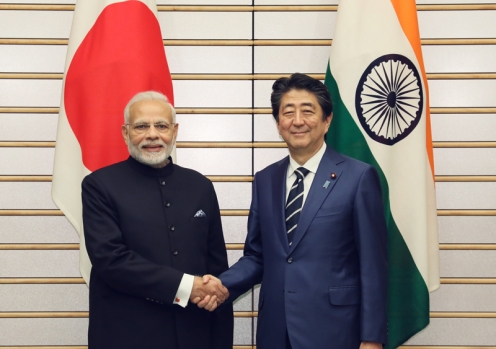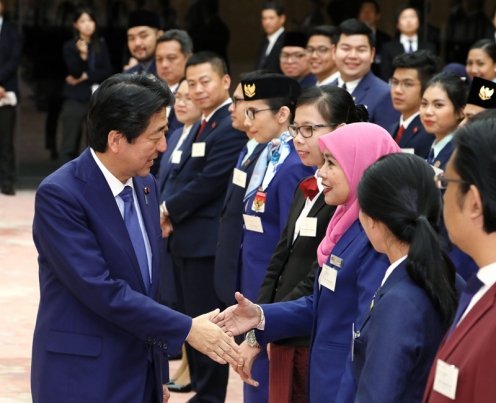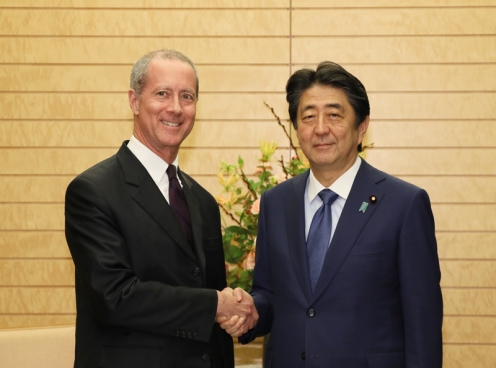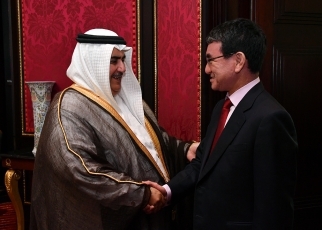Japan-India Summit Meeting and Other Events
Cabinet Secretariat, Monday, October 29, 2018
[Provisional Translation]
On October 29, 2018, Prime Minister Shinzo Abe held a summit meeting and other events with H.E. Mr. Narendra Modi, Prime Minister of India, at the Prime Minister’s Office.
The two leaders attended a salute and guard of honor ceremony, followed by a summit meeting. Afterwards, with a ceremony for signing and exchange of documents and a joint press announcement being held, the leaders signed the Japan-India Vision Statement and Factsheet.
Lastly, the Prime Minister hosted a banquet at the Prime Minister’s Official Residence and said in his address,
“Namaste. I have just learned from Prime Minister Modi that the word ‘namaste’ has a much deeper meaning than ‘hello.’ I encourage everyone who is interested in it to later ask about the meaning to those who know.
I would like to once again warmly welcome Prime Minister Modi to Japan. It is my great pleasure to receive my close friend Prime Minister Modi in Japan for the third time.
Last night, I invited Prime Minister Modi to my vacation home in Yamanashi Prefecture. He is the first foreign prime minister to visit that residence. We had dinner just the two of us and discussed the future of the Japan-India relationship and various global issues in depth.
In Yamanashi, we also visited a state-of-the-art robotics plant of a company that has expanded its business to India. Many engineers from India are improving their skills at the training center on the premises of the plant. I heard that our guide yesterday, the President and CEO of their subsidiary company in India, is the great-granddaughter of Mahatma Gandhi. Having last year visited Gujarat, which is closely associated with Gandhi, I felt a deep sense of connection.
The Japan-India relationship is expanding its horizons which are not limited to the areas of business and cutting-edge technologies. The number of visitors from India to Japan has approximately doubled over the last five years.
Yesterday, the plan was to view Mt. Fuji with Prime Minister Modi. The weather, however, does not always go as planned. We were nevertheless able to see the beautiful autumn foliage. That said, we were still able to get a peak of the summit, the middle, and the foot of the mountain, so I think Prime Minister Modi got a picture of the general contours of Mt. Fuji. Meanwhile, Prime Minister Modi also had a leisurely Japanese meal. The Prime Minister looked to be enjoying his delicious, special vegetarian Japanese meal. I hope many more people of India will visit Japan to enjoy the nature of Japan and Japanese cuisine.
At every opportunity, I have stated that the Japan-India relationship is a bilateral relationship with the most potential. The guests invited today are leaders who have made significant contributions in various fields so as to unleash to the fullest the potential that the Japan-India relationship holds.
I am looking forward to continuing to work together with all of you to ensure that this potential we have is fully realized and ask for your continued contribution to this end.
With that, I would like to offer a toast to the good health of Prime Minister Modi and everyone in attendance and to the deepening of the bilateral relationship.”
Exchange of Notes Concerning Yen Loans to India
Foreign Affairs, Monday, October 29, 2018
1. On October 29, Mr. Kenji Hiramatsu, Ambassador Extraordinary and Plenipotentiary of Japan to India, and H.E. Mr. Sujan R. Chinoy, Ambassador Extraordinary and Plenipotentiary of India to Japan, exchanged notes concerning the provision of yen loan related to seven projects including the Project for the Construction of Mumbai-Ahmedabad High Speed Rail (II) (total loan provision of up to 316.458 billion yen) in the presence of Mr. Shinzo Abe, Prime Minister of Japan and H.E. Mr. Narendra Modi, Prime Minister of India, in Tokyo following the Japan-India Summit Meeting.
2. Overview of the projects
(1) Loan to construct a high-speed rail with the introduction of the Shinkansen system of Japan, a flagship project representing the “new era in Japan-India relations”
(Yen loan project “Project for the Construction of Mumbai-Ahmedabad High Speed Rail (II)” (loan up to 150 billion yen))
This project is to provide a loan to the Government of India for the construction of a high speed rail with the introduction of Japan’s Shinkansen system between Mumbai in Maharashtra and Ahmedabad in Gujarat. It is expected that the new high speed train will be able to travel that distance in two hours, compared with the seven hours required by the current express train service for the distance of 500 kilometers between Mumbai and Ahmedabad. Through the realization of a high frequency, mass passenger transportation system, this project will contribute to the efficiency of the transportation network and promote economic development in the broad target areas.
(2) Loan to renovate a hydroelectric power station to contribute to the promotion of renewable energy in Meghalaya
(Yen loan project “Project for Renovation and Modernization of Umiam-Umtru Stage-III Hydroelectric Power Station” (loan up to 5.497 billion yen))
This project is to provide a loan to the Government of India for carrying out renovation of two units of the Umiam-Umtru stage-III hydroelectric power station in the river basin of the Umiam River and Umtru River. Though currently due to turbine damage and other issues, there are unplanned power stoppages of approximately 7,600 hours per year for the first unit, and approximately 4,000 hours per year for the second unit, it is expected to shorten the stoppages to approximately 90 hours per year for both in 2025 (two years after the project is completed). Thus, this project will contribute to industrial development and improvement of living standards in Meghalaya.
(3) Loan to extend and expand the Delhi Metro network, a representative example of Japan’s economic cooperation in India
(Yen loan project “Delhi Mass Rapid Transport System Project (Phase 3) (III)” loan up to 53.675 billion yen))
This project is to provide a loan to the Government of India for the construction of approximately 116 kilometers metro system in the capital city of Delhi. It is expected that the daily passengers of the entire Delhi Metro will increase from approximately 1.9 million people at the groundbreaking of phase 3 of the project (2012) to approximately 2.7 million. Thus, this project will contribute to easing traffic congestion and reducing traffic pollution.
(4) Loan to construct a bridge in India’s North Eastern Region to contribute to enhancing connectivity
(Yen loan project “North East Road Network Connectivity Improvement Project (Phase 3) (I)” (loan up to 25.483 billion yen))
This project is to provide a loan to the Government of India for the construction of a bridge connecting Dhubri in Assam and Phulbari in Meghalaya (total length of approximately 20 kilometers). It is expected that approximately 2.95 million people will use the bridge annually and the traveling time will be reduce from approximately 8 hours 13 minutes of the alternative route to approximately 23 minutes in 2030 (two years after the project is completed). Thus, this project will contribute to promotion of economic development in the region.
(5) Loan to construct a pumped storage power station to contribute to the promotion of renewable energy in West Bengal
(Yen loan project “Project for the Construction of Turga Pumped Storage (I)” (loan up to 29.442 billion yen))
This project is to provide a loan to the Government of India for the construction of a pumped storage power station in Purulia of West Bengal. It is expected that the annual power generation amount could rise to 1,803 gigawatt hours in 2029 (two years after the project is completed), which is equivalent to the annual electricity usage amount of approximately 2.8 million households. Thus, this project will contribute to industrial development and improvement of living standards in West Bengal.
(6) Loan to construct a peripheral ring road around Chennai metropolitan area, which has serious and chronic traffic congestion
(Yen loan project “Project for the Construction of Chennai Peripheral Ring Road (Phase 1)” (loan up to 40.074 billion yen))
This project is to provide a loan to the Government of India for the construction of the section of an access road to Ennore Port (organized into the main line and a branch line) in the northern part of Chennai in Tamil Nadu as part of the peripheral ring road (approximately 133 kilometers). It is expected that the traveling time required for the improved section of the main line (approximately 31.4 kilometers) will be reduced from the current approximately 50 minutes to approximately 22 minutes, and the time required for the branch line (approximately 23.7 kilometers) will be reduced from current approximately 36 minutes to approximately 22 minutes. Thus, this project will contribute to economic development of the metropolitan area.
(7) Loan for tree-planting activities in Tripura, where there is advancing forest area reduction and deterioration of the residents' living environment
(Yen loan project “Project for Sustainable Catchment Forest Management in Tripura” (loan up to 12.287 billion yen))
This project is to provide a loan to the Government of India for sustainable forest management, water and soil conservation activities and livelihood enhancement activities in Tripura. It is expected that the quality of the area forests will increase thorough the participation of approximately 23,000 local residents and personnel from executing agency, and forestation on approximately 42,000 hectares. Thus, this project will contribute to forest ecosystem improvement and livelihood enhancement for the local residents in Tripura.
3. Loan terms
(1) For projects (1) in 2. above
i. Interest rate : 0.1% per annum
ii. Repayment period : 50 years (including a 15-year grace period)
iii. Procurement terms : Tied
(2) For projects (2), (3), (4), and (5) in 2. above
i. Interest rate : 1.5% per annum (0.01% per annum for consulting services)
ii. Repayment period : 30 years (including a 10-year grace period)
iii. Procurement terms : General untied
(3) For projects (6) in 2. above
i. Interest rate : 1.45% per annum (0.01% per annum for consulting services)
ii. Repayment period : 30 years (including a 10-year grace period)
iii. Procurement terms : General untied
(4) For projects (7) in 2. above
i. Interest rate : 1.25% per annum (0.01% per annum for consulting services)
ii. Repayment period : 30 years (including a 10-year grace period)
iii. Procurement terms : General untied
Agreement-in-principle to conclude the BSA between Japan and India up to USD 75 billion
Ministry of Finance, Monday, October 29, 2018
Agreement-in-principle to conclude the Bilateral Swap Arrangement
between Japan and India up to USD 75 billion
With a view to enhancing financial and economic cooperation, thereby further developing the economic and trade ties between the two countries and contributing to the stability of financial markets, Governments of Japan and India welcomed the agreement-in-principle to conclude a Bilateral Swap Arrangement (BSA) of up to USD 75 billion.
With regard to External Commercial Borrowing (ECB), no mandatory hedging will be required for infrastructure ECB of more than 5 years minimum average maturity.
The new BSA, together with continued reforms in financial and investment sectors in India including ECB, would promote stable and long-term capital inflows into India.
Regarding the Decision by the Supreme Court of the Republic of Korea, Confirming the Existing Judgments on the Japanese Company (Statement by Foreign Minister Taro Kono)
Foreign Affairs, Tuesday, October 30, 2018
1. Japan and the Republic of Korea have built a close, friendly and cooperative relationship based on the Treaty on Basic Relations between Japan and the Republic of Korea and other relevant agreements that the two countries concluded when they normalized their relationship in 1965. The Agreement on the Settlement of Problems concerning Property and Claims and on Economic Co-operation between Japan and the Republic of Korea (hereinafter referred to as “the Agreement”), which is the core of these agreements, stipulates that Japan shall supply to the Republic of Korea 300 million USD in grants and extend loans up to 200 million USD (Article I), and that problems concerning property, rights and interests of the two Contracting Parties and their nationals (including juridical persons) as well as concerning claims between the Contracting Parties and their nationals are “settled completely and finally,” and no contention shall be made thereof (Article II). As such, the Agreement has provided the basis for the bilateral relationship up until now.
2. In spite of the above, today on October 30, the Supreme Court of the Republic of Korea decided to confirm the previously existing Korean judgments as final, which ordered Nippon Steel & Sumitomo Metal Corporation, inter alia, to pay compensation to the plaintiffs. This decision is extremely regrettable and totally unacceptable. This decision clearly violates Article II of the Agreement and inflicts unjustifiable damages and costs on the said Japanese company. Above all, the decision completely overthrows the legal foundation of the friendly and cooperative relationship that Japan and the Republic of Korea have developed since the normalization of diplomatic relations in 1965.
3. Japan once again conveys to the Republic of Korea its position as elaborated above, and strongly demands that the Republic of Korea take appropriate measures, including immediate actions to remedy such breach of international law.
4. Furthermore, if appropriate measures are not taken immediately, Japan will examine all possible options, including international adjudication, and take resolute actions accordingly from the standpoint of, inter alia, protecting the legitimate business activities by Japanese companies. As part of such effort, in order for the Ministry of Foreign Affairs to fully address this matter, today, the Ministry of Foreign Affairs has established the Division for Issues Related to Claims between Japan and the Republic of Korea in the Asian and Oceanian Affairs Bureau.
(Reference) Agreement on the Settlement of Problem Concerning Property and Claim and on the Economic Co-operation between Japan and the Republic of Korea (excerpt)
Article II
1. The Contracting Parties confirm that problem concerning property, rights, and interests of the two Contracting Parties and their nationals (including juridical persons) and concerning claims between the Contracting Parties and their nationals, including those provided for in Article IV, paragraph (a) of the Treaty of Peace with Japan signed at the city of San Francisco on September 8, 1951, is settled completely and finally.
・・・
3. Subject to the provisions of paragraph 2 above, no contention shall be made with respect to the measures on property, rights and interests of either Contracting Party and its nationals which are within the jurisdiction of the other Contracting Party on the date of the signing of the present Agreement, or with respect to any claims of either Contracting Party and its nationals against the other Contracting Party and its nationals arising from the causes which occurred on or before the said date.
Courtesy Call from Representatives of the Ship for Southeast Asian and Japanese Youth Program and Others
Cabinet Secretariat, Wednesday, October 31, 2018
[Provisional Translation]
On October 31, 2018, Prime Minister Shinzo Abe received a courtesy call from representatives participating in the Ship for Southeast Asian and Japanese Youth Program (SSEAYP) and others, at the Prime Minister’s Office.
The Prime Minister said in his opening address,
“I would like to sincerely welcome all of you to Japan who have come as the representatives of the countries participating in the 45th SSEAYP.
Since I became Prime Minister, I have visited all ten of your countries. Even now, I remember and am grateful for the warm hospitality in all the places I visited. ASEAN celebrated its 50th anniversary last year, and I anticipate that ASEAN will continue to lead regional stability and prosperity as a partner with which Japan shares fundamental values.
On October 9, I welcomed the leaders of five countries to Tokyo: Cambodia, Laos, Myanmar, Thailand, and Viet Nam. We held the Mekong-Japan Summit Meeting on that occasion, and agreed to deepen people-to-people exchanges in various fields.
It is people who will carve out the future, and this rests on the capabilities of young people in particular. SSEAYP is one of the cooperation programs that attaches importance to people. More than 12,000 young people have participated in this program so far. Building on this experience, they are currently fulfilling active roles in their respective fields.
During the Program, you will likely make many new friends from countries with different histories, cultures, and values through homestays in the countries you visit, as well as through the time you share living on the ship. I hope that you will foster close bonds by having extensive conversations with one another, learning about the wonderful qualities of each other’s countries, and affirming your pride in the country where you were born and raised.
I hope that you will cherish the friendships you cultivate on this ship and continue to take advantage of this network in the future. I look forward to your great success.”
Courtesy Call from a Delegation Led by the Chairman of the U.S. House Armed Services Committee
Cabinet Secretariat, Wednesday, October 31, 2018
[Provisional Translation]
On October 31, 2018, Prime Minister Shinzo Abe received a courtesy call from a delegation led by Chairman Mac Thornberry of the U.S. House Armed Services Committee, at the Prime Minister’s Office.[Provisional Translation]
On October 31, 2018, Prime Minister Shinzo Abe received a courtesy call from a delegation led by Chairman Mac Thornberry of the U.S. House Armed Services Committee, at the Prime Minister’s Office.
Japan-Bahrain Foreign Ministers' Meeting
Foreign Affairs, Saturday, October 27, 2018
On Saturday, October 27 from 3:35 p.m. (local time; (9:35 p.m. Japan time) for approximately 20 minutes, Mr. Taro Kono, Minister for Foreign Affairs, held a meeting with H.E. Shaikh Khalid bin Ahmed bin Mohammed Al Khalifa, Minister of Foreign Affairs of the Kingdom of Bahrain, in Manama, Bahrain. The overview of the meeting is as follows.
At the outset, Minister Kono said that he intends to work closely together with Minister Khalid to promote bilateral cooperation and realize stabilization in the region. He also stated Japan's commitment to maintain stability in the Middle East and its intention to contribute to long-term stability in the region.
In response, Minister Khalid said that he intends to work together with Minister Kono to expand the bilateral relations in various fields and expressed his appreciation for the active role played by Japan towards stability in the Middle East. In addition, Minister Khalid expressed his intention to continue to work with Minister Kono to enhance the relationship of the two countries.
Furthermore, the two ministers discussed regional affairs, including the situation in the Middle East and the issue of North Korea, and Minister Kono emphasized Japan's intention to provide maximum support towards stability in the Middle East. Minister Khalid expressed high expectations for Japan's role in achieving stability in the Middle East.
Statement on Monetary Policy
Bank of Japan, Wednesday, October 31, 2018
1. At the Monetary Policy Meeting held today, the Policy Board of the Bank of Japan decided upon the following.
(1) Yield curve control
The Bank decided, by a 7-2 majority vote, to set the following guideline for market operations for the intermeeting period. [Note 1]
The short-term policy interest rate:
The Bank will apply a negative interest rate of minus 0.1 percent to the Policy-Rate
Balances in current accounts held by financial institutions at the Bank.
The long-term interest rate:
The Bank will purchase Japanese government bonds (JGBs) so that 10-year JGB
yields will remain at around zero percent. While doing so, the yields may move upward and downward to some extent mainly depending on developments in economic activity and prices.1 With regard to the amount of JGBs to be purchased, the Bank will conduct purchases in a flexible manner so that their amount outstanding will increase at an annual pace of about 80 trillion yen.
(2) Guidelines for asset purchases
With regard to asset purchases other than JGB purchases, the Bank decided, by a unanimous vote, to set the following guidelines.
a) The Bank will purchase exchange-traded funds (ETFs) and Japan real estate investment trusts (J-REITs) so that their amounts outstanding will increase at annual paces of about 6 trillion yen and about 90 billion yen, respectively. With a view to lowering risk premia of asset prices in an appropriate manner, the Bank may increase or decrease the amount of purchases depending on market conditions.
In case of a rapid increase in the yields, the Bank will purchase JGBs promptly and appropriately. 1
Statement on Monetary Policy
b) As for CP and corporate bonds, the Bank will maintain their amounts outstanding at about 2.2 trillion yen and about 3.2 trillion yen, respectively.
2. The Bank will continue with "Quantitative and Qualitative Monetary Easing (QQE) with Yield Curve Control," aiming to achieve the price stability target of 2 percent, as long as it is necessary for maintaining that target in a stable manner. It will continue expanding the monetary base until the year-on-year rate of increase in the observed consumer price index (CPI, all items less fresh food) exceeds 2 percent and stays above the target in a stable manner. As for policy rates, the Bank intends to maintain the current extremely low levels of short- and long-term interest rates for an extended period of time, taking into account uncertainties regarding economic activity and prices including the effects of the consumption tax hike scheduled to take place in October 2019. It will examine the risks considered most relevant to the conduct of monetary policy and make policy adjustments as appropriate, taking account of developments in economic activity and prices as well as financial conditions, with a view to maintaining the momentum toward achieving the price stability target. [Note 2]
[Note 1] Voting for the action: Mr. H. Kuroda, Mr. M. Amamiya, Mr. M. Wakatabe, Mr. Y. Funo, Mr. M. Sakurai, Ms. T. Masai, and Mr. H. Suzuki. Voting against the action: Mr. Y. Harada and Mr. G. Kataoka. Mr. Y. Harada dissented, considering that allowing the long-term yields to move upward and downward to some extent was too ambiguous as the guideline for market operations decided by the Policy Board. Mr. G. Kataoka dissented, considering that, with heightening uncertainties regarding developments in economic activity and prices going forward, it was desirable to strengthen monetary easing so that yields on JGBs with maturities of 10 years and longer would broadly be lowered further.
[Note 2] Mr. Y. Harada dissented, considering that, as for policy rates, it was appropriate to introduce forward guidance that would further clarify its relationship with the price stability target. In order to achieve the price stability target of 2 percent at the earliest possible time, Mr. G. Kataoka dissented, considering that further coordination of fiscal and monetary policy was important, and that it was necessary for the Bank to make a commitment to taking additional easing measures if it revised downward its assessment of medium- to long-term inflation expectations.













































